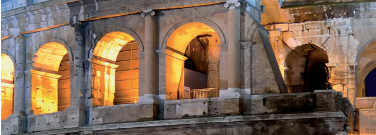Paving the Way: The Secret to Ancient Roman Concrete

By Gina Wynn
If you’ve been to or even read about Europe, you’re probably aware of the ancient Roman amphitheaters, temples, and other structures that have become popular tourist destinations. It’s easy to view them as just typical historical sites, but the fact that the structures are still standing after over 2,000 years is quite remarkable.
A group of Massachusetts Institute of Technology (MIT) researchers led by chemist Admir Masic set out to learn what makes the structures so resilient. They discovered an ingredient in the concrete building material that may have given it a self-healing capability.
After investigating samples from a 2,000-year-old city wall at a site near Rome in Privernum, they concluded that calcium oxide, also called quicklime, has been boosting the longevity of the concrete. The results of their study were published in Science Advances.
Long-Lasting Lumps
In the lab, the group focused on tiny calcium deposits in the concrete. Although some scientists believed they were the result of poor mixing techniques, Masic and his team thought they could have been caused by quicklime in the dry concrete mixture.
Mixing quicklime with water initiates an exothermic chemical reaction. The heat produced would have stopped the lime from fully dissolving, creating lime lumps or “clasts” in the hardened concrete. When the researchers recreated the process using quicklime, the resulting material matched their samples from Privernum, lumps and all.
When the group filled the cracks in the concrete with water, the quicklime lumps dissolved and recrystallized, repairing fractures as wide as 0.6 millimeters. This self-healing characteristic may be behind the longevity of the structures that have been standing strong for nearly two millennia.
Learning from History
The Romans likely made the transformative quicklime by heating limestone to produce the white calcium oxide powder. Then they combined it with other ingredients to create their indispensable material.
“The new results show that at the basis of ancient Roman concrete’s self-healing and longevity could be the way Romans mixed their raw ingredients, specifically how they used lime, the key component of the mix besides volcanic ash,” said Masic, according to the Reuters article “Scientists chip away at how ancient Roman concrete stood test of time” by Will Dunham.
Although the Romans didn’t invent concrete, they used it regularly in construction by 200 B.C.E. The material they called opus caementicium is more durable and practical than the concrete in use today. Modern concrete structures can begin to deteriorate within decades of being built.
A New Foundation
The MIT findings may lay the foundation for developing new types of self-healing concrete that can withstand the elements and time and reduce the need for costly repairs. And since cement production accounts for eight percent of the world’s CO2 emissions, reducing the amount of concrete we use on sealing cracks and rebuilding walls would also be good for the planet.
Discussion Questions
- Name some modern structures that are made from concrete.
- How can reducing the amount of concrete we use help the environment?
